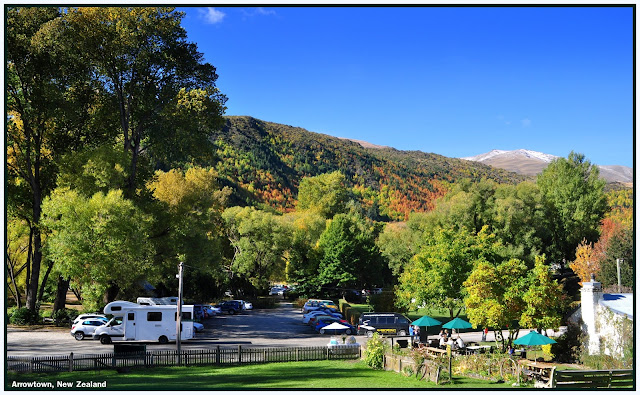17 April 2015
We did not go straight to Queenstown from Wanaka. Instead, we spent a pleasant day in the beautiful Arrowtown. In April and May Arrowtown ignites with colour as deciduous trees prepare for winter. Arrowtown is full of trees. The council even introduced a special zone called the Residential Arrowtown Historic Management Zone, which restricts any maintenance of removal of trees in that area.
A 30-minute walk to the top of Tobins track will reward you with unsurpassed views of Arrowtown and the further Wakatipu basin. Tobins Track entrance is at the bottom of Ford Street (off Centennial Avenue and Bedford Street corner). The bridge takes you across the Arrow River
Someone please tell me what these are. They can be easily spotted along the track
At the top of Tobins Track is a trig station and two seats provided by the Stevenson family for walkers to enjoy the view and rest awhile.
We picked apples but they were sour.
I do not remember if we finished the Arrow River Trail either because the path was muddy or it was blocked by fallen trees. This 50-minute return trail should bring you to a picturesque waterfall.
If you love Lord of the Rings, you consider the 4WD safari tour to the LOTR scenes.
It’s easy to see why Lake Hayes is called ‘the most photographed lake in New Zealand’ or ‘mirror lake’ . Reflecting the majestic mountains of the Wakatipu Basin and the earthy tones of the landscape, this lake offers a million and one Kodak moments.
A special highlight in Arrowtown is the Chinese settlement at the edge of the river. Built by Chinese miners from 1868, this area of restored shelters and buildings paints a picture of earlier times. It was interesting to go into the tiny houses and have a look around.
Census figures for 1874 reveal that there were 3,564 Chinese in Otago. Often victims of discrimination they lived on the fringes of European settlements and in isolated gullies close to their mining claims. Chinese that died were either buried in graves in a Chinese section or just outside the cemetery.
By 1885, the Arrowtown settlement had grown to consist of about ten huts, a large social hall and at least two stores. There was also an extensive garden area. A range of construction techniques was used for the buildings, including mud brick, mortared stone, wood, corrugated iron, and canvas. Some buildings were thatched while others were roofed with corrugated iron.
At first the men lived together in communal huts, usually between two and six men to a house. It seems that the community centred around the large social hall, which was perhaps fifteen metres long, until it collapsed or was demolished in around 1900.
It seems that Ah Lum’s store (separately registered as an historic place) later took over this social function. It is unlikely if any women ever lived in the settlement; the first recorded arrival of a Chinese woman in New Zealand was not until 1873 and by 1896 there were only eleven throughout the country.
The heart of Arrowtown's history is Buckingham Street, a procession of small town heritage buildings that stretch into a tree lined avenue of tiny miners’ cottages. The buildings in this lovely precinct, house shops, galleries, bars, and restaurants – many classy, most individual, not one from an international chain.
Comb
Scarecrows can be easily spotted in town. I believed they were left from the scarecrow competition, part of the Arrowtown Autumn Festival
You may be interested also in my previous trip in Arrowtown





























No comments:
Post a Comment